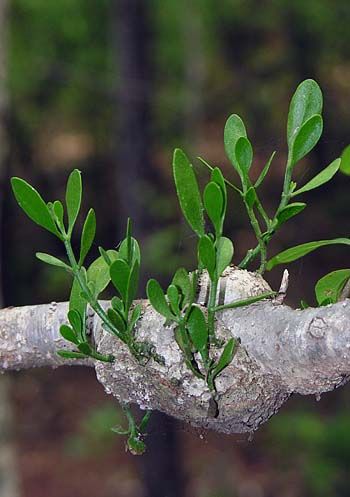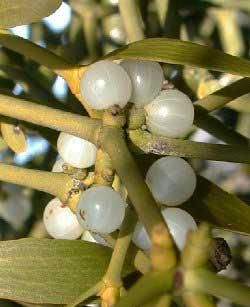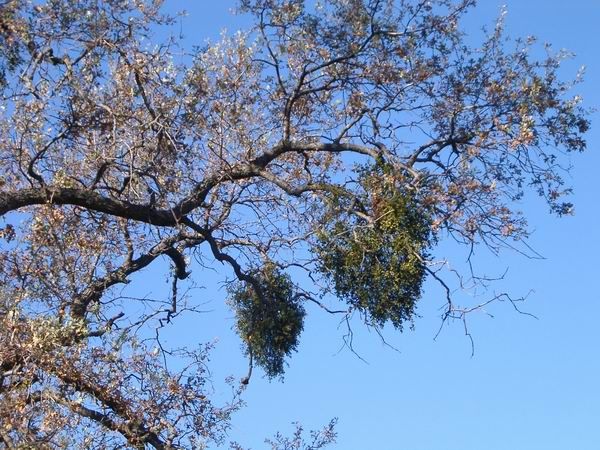Viscum album


Common name: Mistletoe, Birdlime Mistletoe, Herbe de la Croix, Mystyldene, Lignum Crucis
Family: Loranthaceae
Exposure: sun to partial shade
Bloom time: Late Winter - Mid Spring
Habitat: Throughout Europe, Asia and North Africa (North American mistletoe is a completely different species)
Description: Its stem is very short but it' s got many branches repeatedly forking, so they make a sort of a big clump hanging from the invaded tree.

Propagation:
The best time to propagate mistletoe is from March to April when the seed is fully ripe. Ensure the seed is intact and hasn't split. If possible, select a host tree that is from the same species as where the mistletoe was harvested, find a branch with a girth of more than 10cm (4in) - a high branch is better because it's more exposed to sunlight. Remove the white, fleshy seed coating, make a shallow insertion into the bark of the chosen branch with a knife and insert the seed under the layer of bark. Secure the layer of bark with twine and cover the seed with material, such as hessian, to prevent birds reaching it. It's advisable to propagate more than one seed; the success rate of germination is quite low, with only about one in ten seeds becoming a plant.
Myths and facts about mistletoe: - Druids believed mistletoe growing on oak trees was the most sacred form of the plant and it offered protection from all evil, as well as being the source of much magic.
- Druids believed mistletoe growing on oak trees was the most sacred form of the plant and it offered protection from all evil, as well as being the source of much magic.
- The mystery of the mistletoe's method of reproduction led many people to link the plant with spontaneous generation, fertility and aphrodisiacs. In medieval times, women wishing to conceive would wrap mistletoe around their waist and wrists to increase their fertility.
- The early Christian church banned the use of mistletoe because of its association with Druids.
- Traditionally in Scandinavia, if enemies met under mistletoe they would lay down their weapons and not fight until the following day.
- According to Scandinavian legend, the god Balder the Beautiful is killed by a spear of mistletoe and so his grieving mother Frigg, the goddess of love and beauty, banishes the plant to the top of trees. When Balder comes backs to life, Frigg makes mistletoe a symbol of love.
- In Brittany the plant is known as Herbe de la Croix because it is thought that Christ's Cross was made of mistletoe wood.
Articole asemănătoare
-
Zambilele Carnegie, prospetime imaculata pentru gradina
Cu parfumul lor dulce si intens alaturi de album imaculat al inflorescentelor, aceasta varietate de zambile este foarte apreciata de cunoscatorii din toata lumea (o veti intalni de altfel adesea si in florarii) pentru frumusetea sa, dar si pentru ca se cultiva relativ usor.
-
Trucuri pentru flori presate rezistente
-
Vascul, o planta cu conotatii magice de Craciun si Anul Nou
Vascul este un element vegetal cu o semnificatie aparte de Craciun, originile intrebuintarii sale avand “radacini” viguroase in istorie. Se pare ca poporul roman l-ar fi mostenit direct de la stramosii lor romani, de vreme ce numele provine din latinescul “Viscum”.
-
Plantele medicinale si beneficiile aduse oamenilor
Inca din antichitate proprietatile curative ale diverselor plante sunt cunoscute si transmise din generatie in generatie. Si astazi, in medicina moderna, plantele se dovedesc a fi utile vindecand miraculos ce medicina conventionala nu reuseste sa vindece.
-
Povestea vascului
